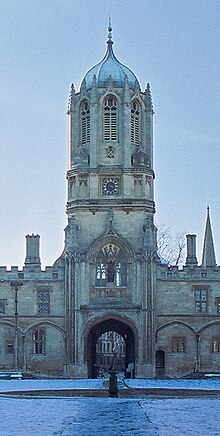Tom Tower

Tom Tower is a bell tower in Oxford, England, named for its bell, Great Tom. It is over the main entrance of Christ Church, Oxford in Tom Quad, on St Aldate's. This square tower with an octagonal lantern and facetted ogee dome was designed by Christopher Wren and built 1681–82. The strength of Oxford architectural tradition and Christ Church's connection to its founder, Henry VIII, motivated the decision to complete the gatehouse structure, left unfinished by Cardinal Wolsey at the date of his fall from power in 1529, and which had remained roofless since. Wren made a case for working in a late Gothic style — that it "ought to be Gothick to agree with the Founders worke"[1] — a style that had not been seen in a prominent building for a hundred and fifty years, making Tom Tower a lonely precursor[2] of the Gothic Revival that got underway in the mid-18th century.[3] Wren never came to supervise the structure as it was being erected by the mason he has recommended, Christopher Kempster, of Burford.[4]
In 1732-34, when William Kent was called upon to make sympathetic reconstruction of the east range of Clock Court in Wolsey's Tudor Hampton Court Palace, he naturally turned to the precedent of Tom Tower for his "central ogee dome with its coronet of pilaster-like gothick finials"[5]
The tower of Dunster House at Harvard University is a direct imitation of Tom Tower, and stones from Christ Church are installed in one of the house's main entryways. It has been pointed out by many Pembroke College students that the best view of Tom Tower is from their porter's lodge, off St Aldates road.
Great Tom
Great Tom, housed in the tower, is the loudest bell in Oxford. It weighs around seven tons and was moved from the 12th century Osney Abbey after the Dissolution of the Monasteries. Traditionally, the bell in Tom Tower is sounded 101 times at 9:05 pm each evening — to recall the original 100 scholars of the college (plus one added in 1663) — before the gates were locked for the night.
Originally called "Mary", Great Tom used to hang in Osney Abbey, until in 1545 it was moved to St Frideswide's church, after which at some point it was renamed "Tom". It had caused problems since its first casting, wearing out its clapper, and was recast in 1612, 1626, and 1654, but without solving the problem. In 1678–1679, Richard Keene of Woodstock tried three times to recast it, in the process increasing its weight from two to over six tons, but it wasn't until a final recasting in 1680 – by Christopher Hodson, a bell-founder from London – that success was achieved, and the resulting bell, Great Tom, was hung in the newly completed Tom Tower. It was rehung in May 1953.
There is an inscription on the bell in Latin, which translated reads:
"Great Thomas the door closer of Oxford renovated April 8 1680 in the reign of Charles II. Deacon John, the Bishop of Oxford and sub Deacon give thanks to the knowledge of Henry Smith and the care and workmanship of Christopher Hodson".
Great Tom is still sounded 101 times every night, which signifies the 100 original scholars of the college plus one (added in 1663). It is rung at 21:05, which corresponds to what used to be "Oxford time" (when different parts of the country set their clocks according to their distance from the Greenwich meridian), and was at one time the signal for all the Oxford colleges to lock their gates. The bell is only rung by swinging on very special occasions.
The bell is the subject of a number of Oxfordshire Morris tunes and rounds, including "Old Tom of Oxford" (from Bampton), and the rounds "Great Tom Is Cast" and "Bonny Christ Church Bells", which were composed by the Dean of Christ Church, Henry Aldrich (1647–1710).
See also
Notes
- ^ Wren Society 5 (Oxford: Clarendon Press) 1928:17.
- ^ Some other work by Wren, Sir Nicholas Hawksmoor and William Dickinson in the Office of Works is discussed in Giles Worsley, "The Origins of the Gothic Revival: A Reappraisal: The Alexander Prize Essay"Transactions of the Royal Historical Society 6th Series 3 (1993), pp. 105-150.
- ^ Other Gothic work by Wren includes restorations in Westminster Abbey.
- ^ Seven letters of Wren to John Fell, Bishop of Oxford, and other documents were published in Wren Society 5 (1928).
- ^ Juliet Allan, "New Light on William Kent at Hampton Court Palace" Architectural History 27 (1984, pp. 50-58), p. 52. Kent's alterations, his first attempt at Gothick, quickly became dated as the Gothic Revival progressed, and were revised in a correcter taste.
References
- Jennifer Sherwood and Nikolaus Pevsner, The Buildings of England: Oxfordshire. ISBN 0-14-071045-0.
- Wren Society vol 5: "Designs of Sir Christopher Wren for Oxford, Cambridge..." (1928).
External links
- Images of Tom Tower
- W.H. Auden (1907–1973) Under Tom Tower by Richard Ellmann
- Great Tom bell
- History of legal time in Britain by Joseph Myers
